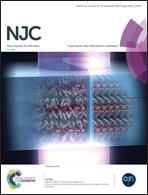Emergence of bismuth substituted cobalt ferrite nanostructures as versatile candidates for the enhanced oxidative degradation of hazardous organic dyes†
Abstract
Bismuth, a post-transition metal element, has attracted significant attention for its incorporation into the ferrite sub-lattice for tuning different physical and chemical characteristics, thereby drastically affecting the catalytic performance. The present investigation focuses on the substitution of bismuth into the lattice of cobalt ferrite for use as an efficient catalyst for the oxidative degradation of hazardous organic dyes, both in the presence and absence of visible light irradiation. A series of bismuth-doped cobalt ferrite nanostructures (CoBixFe2−xO4, x = 0.02, 0.04, 0.06, 0.08, 0.1) was fabricated via the facile sol–gel methodology. The amount of bismuth doped into the cobalt ferrite lattice played an important role in determining the rate of the degradation reaction. The drastic enhancement in the catalytic efficacy was observed via the incorporation of just 1% bismuth (x = 0.02), replacing iron in the cobalt ferrite lattice due to its octahedral site preference. With further increase in the bismuth content up to 3% (x = 0.04 and 0.06), there was a slight improvement in the catalytic behavior, but beyond x = 0.06, there was a decrease in the catalytic behavior. This could be attributed to the mixed tetrahedral and octahedral site occupancy for the former, and catalytically inactive tetrahedral site occupancy of bismuth ions for the latter. Therefore, CoBi0.02Fe1.98O4 possessed the best catalytic performance of all the bismuth-incorporated samples. The observed trend of the catalytic efficacy of bismuth-doped cobalt ferrite could be related to the physical characteristics such as crystallite size, saturation magnetization and band gap. Additionally, very good recyclability of the synthesized samples highlighted their applicability as potential recyclable catalysts for the remediation of hazardous dyes.



 Please wait while we load your content...
Please wait while we load your content...